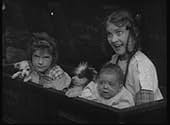Ajouter une intrigue dans votre langueThe fact that an Indian tribe is eating puppies starts an action-packed battle in a Western town.The fact that an Indian tribe is eating puppies starts an action-packed battle in a Western town.The fact that an Indian tribe is eating puppies starts an action-packed battle in a Western town.
Kate Bruce
- Settler
- (non crédité)
Charles Gorman
- Among the Indians
- (non crédité)
Elmo Lincoln
- Cavalryman
- (non crédité)
Betty Marsh
- Child
- (non crédité)
W. Chrystie Miller
- Settler
- (non crédité)
W.C. Robinson
- Among the Indians
- (non crédité)
Histoire
Le saviez-vous
- AnecdotesThe film was released in Germany four and a half months before its official premiere in the US.
- Versions alternativesIn the 1920s, the Aywon Film Corporation distributed a 37 minute version; the added length is due to the editing and new titling by M.G. Cohn and J.F. Natteford. This version includes extended opening credits and added intertitles in the style of 1920s titling.
- ConnexionsFeatured in Langlois (1970)
Commentaire à la une
Given the limited cinematic methods available in 1913, this is an impressive achievement, and it still makes for pretty good viewing today. It's also interesting in that its perspective is largely morally-neutral (except perhaps from what today's viewers might read into it), so that the excitement comes mostly from the danger of the situation, rather than from one side being entirely right and the other being entirely wrong.
The build-up to the battle is done rather well, enabling you to identify with the characters, while making some points of its own. Neither side in the confrontation is really in the right, yet Griffith's technique arouses your keen interest in the events to come.
But it is the filming of the actual "Battle at Elderbush Gulch" that is so noteworthy. To create such a sensation of action, turmoil, and emotion using the limited camera field of the times is remarkable. There are a lot of carefully chosen and composed shots, and Griffith also adds in some techniques that were new or relatively new at the time. There are several well-chosen 'iris' shots, and a variety of close-in and distant camera fields that pull you in and out of the action as the director wishes.
It's a fine achievement for its time, at the very least in technical terms, and would probably be well worth a look today for those with an interest in silent movies.
The build-up to the battle is done rather well, enabling you to identify with the characters, while making some points of its own. Neither side in the confrontation is really in the right, yet Griffith's technique arouses your keen interest in the events to come.
But it is the filming of the actual "Battle at Elderbush Gulch" that is so noteworthy. To create such a sensation of action, turmoil, and emotion using the limited camera field of the times is remarkable. There are a lot of carefully chosen and composed shots, and Griffith also adds in some techniques that were new or relatively new at the time. There are several well-chosen 'iris' shots, and a variety of close-in and distant camera fields that pull you in and out of the action as the director wishes.
It's a fine achievement for its time, at the very least in technical terms, and would probably be well worth a look today for those with an interest in silent movies.
- Snow Leopard
- 6 sept. 2001
- Permalien
Meilleurs choix
Connectez-vous pour évaluer et suivre la liste de favoris afin de recevoir des recommandations personnalisées
Détails
- Date de sortie
- Pays d’origine
- Langues
- Aussi connu sous le nom de
- La batalla de Elderbush Gulch
- Lieux de tournage
- Société de production
- Voir plus de crédits d'entreprise sur IMDbPro
- Durée29 minutes
- Couleur
- Mixage
- Rapport de forme
- 1.33 : 1
Contribuer à cette page
Suggérer une modification ou ajouter du contenu manquant

Lacune principale
By what name was The Battle of Elderbush Gulch (1913) officially released in Canada in English?
Répondre























